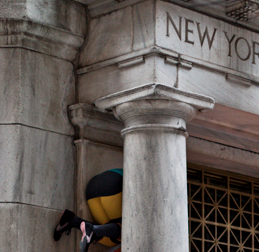Malcolm Gladwell Also Knows Twitter Won't Change Your Tires, Make You Lunch
I appear to be one of the few who agree with Malcolm Gladwell that vast systems of inequity, such as Jim Crow laws, will not likely be changed by means of people putting up some thoughts on the Twitter. (Still I didn’t realize people were seriously suggesting such a thing!)
Product Placement: 'Wall Street 2': Money Actually Sleeps Quite Well
by Abe Sauer
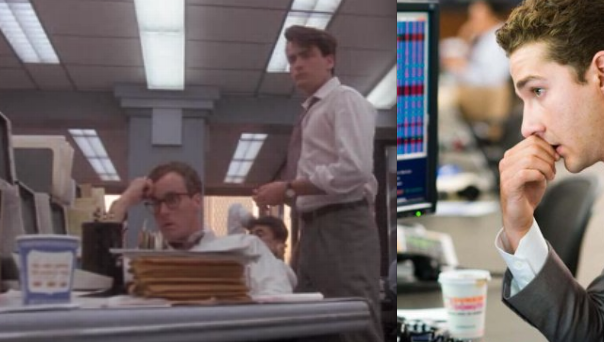
“The main thing about money, Bud, is that it makes you do things you don’t want to do.”
Wall Street 2, better known as Wall Street: Money Never Sleeps, was the top-grossing film in the nation this past weekend.
The hero of the original Wall Street, Bud Fox, was torn between siding with the unionized “working man” or the corporate-raiding embodiment of capitalism. The sequel no longer even bothers with the question, its hero a trader fully invested in working within the system of finance as our savior. The ostentatiousness of the first Wall Street film was found in the characters’ ideals. The ostentatiousness of the sequel is all about the products, many of them placed. One of those products is itself.
One hopes Stone had a camera running during the studio marketing process because that will be the next Wall Street. A cutthroat campaign straight from Gordon Gekko’s mind itself, the slam, bam, thank-you-ma’am publicity train started with Michael Douglas’ cancer announcement and rolled right on through sponsoring a Sunday Football Night in America game, including special segments featuring former NFL players breaking down the New York Giants defense in slow motion. Meanwhile, an onslaught of television ads competed with midterm election spots for frequency.
A website for Gekko’s fictional book “Is Greed Good?” was set up to drive to the film site. Some studio marketer even got the pleasure of populating Gordon Gekko’s official Twitter feed. (234 followers currently.) On September 20, in an act that would have had Bud Fox choking on his tie in 1987, Oliver Stone rang the NASDAQ opening bell.
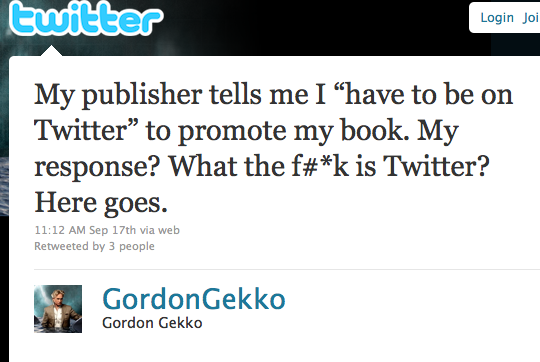
Maybe more telling than anything about the marketing of Wall Street: Money Never Sleeps is that it is rated PG-13. (The original is R.)
“Want a Heineken,” asks Gordon Gekko moments before the beer’s label slides in to fill the screen. The scene takes place at New York’s Shun Lee restaurant, where staff confirmed to us that they do in fact serve Heineken. In the closing credits, the IWC logo floats over the screen like a reflection in a pool. Everything in between is branded. In fact, one difference between the first Wall Street and its sequel is that Money Never Sleeps has a credited crewmember (Allison Robin) responsible solely for “product placement.”
Stone has gone on record to talk about how he involved Wall Street insiders to assure authenticity. But when it came to putting products in those authentic character’ hands, it appears money ruled the day. Millionaire bankers drinking Moët? Sure. The suicidal choose Lay’s chips as a last meal? Why not. Goldman Sachs-like titans of finance race Ducati bikes? Absolutely. That Bulgari is the ring of choice for bankers’ fiancées may be true but there are other news sources than CNBC. Where the original Wall Street featured the iconic Leslie Buck-designed New York coffee cup, now everyone sips on Dunkin’ Donuts.
What’s more, these products are taking credit for their roles. Belstaff’s website boasts of its Wall Street 2 role. Meanwhile, a press release for luxury watch brand IWC reads, “To show who’s boss, standing out-in an understated way-is paramount in the cut-throat world of finance. Jacob Moore couldn’t show his understanding of this philosophy any more-by sporting the IWC Portuguese Perpetual Calendar (Ref. IW502303), he is the true representation of the IWC guy, an educated, driven and talented man ‘in the know’ who has a passion for the finer things in life.”
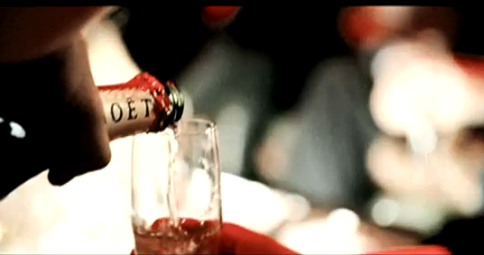
Below, a list of the brands we spotted that made a showing in Wall Street: Money Never Sleeps.
Shun Lee
Barton Perreira Halston
Bulgari
CNBC
Moët
Ducati
Vacheron Constantin
Belstaff
Lay’s
Bed Bath and Beyond
NY Daily News
Nintendo
NY1
Jaeger-LeCoultre
Ferrari
Toyota
Jack Daniels
Ferragamo
Dunkin’ Donuts
Voltz
Dow Jones
Blackberry
Gucci
The New York Post
Heineken
Degree
Johnnie Walker
Cracker Jacks
Forbes
Perrier
CNN
Bloomberg
Borders
Arai
LG
Patrón
Dell
Qdoba
Red Bull
CNBC
Apple
The Bowery Hotel
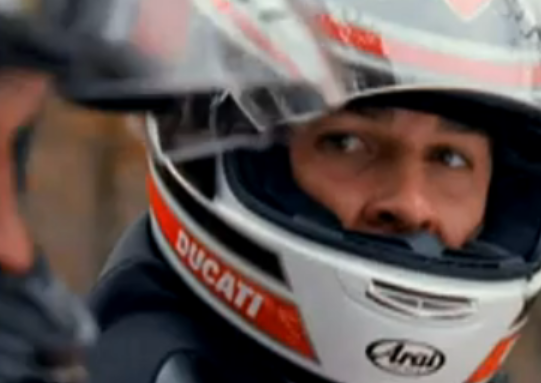
Ellen Mirojnick, Wall Street 2’s costume designer, was also on the blitz, speaking with everyone from Bloomberg to the Chicago Tribune to The Wall Street Journal to make sure all of those brands in the film that could not be identified by label got their due credit, including Barton Perreira Halston sunglasses, Vacheron Constantin watches, Oscar de la Renta and Vera Wang gowns and Jaeger-LeCoultre, whatever it is that brand makes.
In Entertainment Weekly, Josh Brolin says he hopes audiences will see the film and wonder “How much is enough?” Meanwhile, in People, Brolin was grabbing Mirojnick and whispering that “he loved the maroon jacket that he wears in the film.”
To listen to Stone, the sequel is a commentary on the way Wall Street has changed and become more greedy in the time since its 1987 predecessor. But the real commentary of Wall Street 2 is on the business of filmmaking itself. For lack of a better way to put it, product placement is now good. It appears, Oliver Stone loves Andacott Steel, as long as it’s going to help pay for production.
Abe Sauer writes the annual Product Placement Awards and weekly product placement updates for Brandchannel.com
The Ken Burns Defect: Looking Back At 'Baseball'
by Tom Keiser
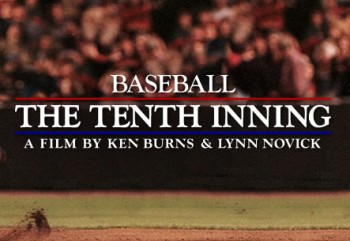
In 1994, four years removed from The Civil War, Ken Burns created Baseball, an eighteen-and-a-half hour (or “Nine Inning”) documentary on the national pastime. In anticipation of Tuesday’s premiere of The Tenth Inning, his four hour epilogue, I went back to watch the original in its entirety.
Baseball is as complicated and intriguing as America’s pastime, and yet it is as clunky and as excessive as its sole corporate sponsor, General Motors, was at the time. Moreover, both the film and GM lose their way somewhere around the 1950’s and 60’s. Baseball becomes one-sided, and what started out as an attempt at populist diversity in telling a story of a people descends into Red Sox bathos and opera-loving elitism.
It wasn’t all Burns’ fault. Baseball premiered only six days after Major League Baseball cancelled its first World Series since 1904. How could he know that instead of a potential Yankees/Expos matchup, this behemoth would be the only game in town?
As popular as Ken Burns was, Baseball had only a budget of around $7.6 million-an astronomical sum for a PBS documentary, but still relatively paltry for a two-hour film, much less one lasting nine times as long. (In comparison, Turner Home Video spent $25 million on promoting its VHS release.) The economy is obvious: the same photo of the Polo Grounds is shown several times. Most of the color footage is taken from the World Series, so, for example, footage of the 1969 Mets illustrates John Chancellor’s narration about their inaugural 40–120 squad of 1962. Most telling is the excessive use of “the Ken Burns effect”: taking a still photo and moving it around as a substitute for actual film. Burns did not originate this technique, but he is now both immortalized and saddled with the term.
Baseball also suffers from Burns’ own success as a prominent documentarian. With the help of PBS, GM, and an array of PR people, Burns saturated the public schools with educational tie-in supplements for Baseball, giving him a platform the Maysles or Errol Morris could only dream of. An entire generation grew up believing that the every documentary must include dramatic narration, black and white photography, and college professors thoughtfully ruminating on the topic.
Baseball also over-intellectualizes its subject. Burns’ frank depiction of racism in society is commendable, yet there is an elitist tone that offsets its progressivism. George Will comes off as a labor sympathizer, a liberal even, which should tell you enough. As Tony Kornheiser, writing in the Washington Post, put it, “It’s not that I don’t like baseball…[i]t’s just that I guess I didn’t go to the right private schools to fully appreciate it.”
In spite of the bourgeois talking heads, there are some great moments and great people in Baseball. The film rescued Negro League player/manager Buck O’Neil from obscurity. It made one almost appreciate the 1979 Pittsburgh Pirates. And it revealed the little-known fact that Rube Waddell, one of the greatest pitchers of his day, was said to have been distracted by puppies and shiny things.
And then we come to Curt Flood. A star centerfielder primarily with the St. Louis Cardinals, Flood was part of a seven player deal that sent him and Tim McCarver to the Philadelphia Phillies for Richie Allen and Cookie Rojas in 1969. Allen’s poor treatment by Philadelphia fans-not to mention the Phillies’ treatment of Jackie Robinson in 1947 and refusal to integrate for over a decade afterwards-gave Flood good reason not to accept the trade (being saddled with McCarver must not have helped either). And yet a rule known as the reserve clause prevented him from signing with another team. His lawsuit against Commissioner Bowie Kuhn was unsuccessful, yet it helped pave the way for the eventual elimination of the reserve clause and the birth of free agency.
Flood was a complicated man; he eventually fled to Spain for a few years, became known as a painter, and passed away of throat cancer in 1997. And yet during the fall of 1994, I felt contempt for what he stood for. In my mind, Curt Flood laid the groundwork for the strike. And while he had nothing directly to do with the strike-the reserve clause was struck down by a technicality in the wording in 1975-he was as much a scapegoat for me in the mid-90’s as he was twenty-five years earlier.
The recently deceased George Steinbrenner was also a victim of bad timing. By 1993, his New York Yankees had not reached the playoffs in over a decade, and Big Stein had just come off his second suspension from MLB. Baseball portrays him as the overbearing mismanager that he was between his second title and his third, yet as the show premiered, his legacy started to improve. Five World Series titles, seven AL pennants, and a mere three managers later, Steinbrenner was lauded after his July passing for making other teams play to his level. Perhaps saddest of all was that Baseball came right before George Costanza’s time with the New York Yankees, so there is no mention of suits smelling like calzones or misinterpretations of Pat Benatar’s “Heartbreaker”.
None of this is as uncomfortable to watch as the constant self-pity of intellectual Boston Red Sox fans. Baseball came before the dramatic end to The Curse of The Bambino, and the recent renewal of the Yankees/Sox rivalry which culminated in two classic ALCS battles in 2003 and 2004. Most of the final “innings” are seen through the eyes of pitcher Bill “Spaceman” Lee, who as baseball goofs go, takes the game way too seriously. Also present at Red Sox Nation’s pity party is historian Doris Kearns Goodwin, who has the bad luck of rooting for both the Brooklyn Dodgers and the Red Sox, and difficulty in making that at all interesting.
One of the final great peaks of action in Baseball is Game Six of the 1986 World Series, but it is shown in such poor quality that you’d rather watch an RBI Baseball rendition of it. We get no mention of how a New York Met fan grasps the situation, no feeling of joy when Ray Knight scores on Bill Buckner’s error. And it distills what was the perhaps greatest playoffs in Major League Baseball history, full of extra innings and heartbreaking losses, into one giant bummer. We’re left only with feelings of what might have been for Boston, when the sad tale of Donnie Moore-who was blamed for the California Angels’ ALCS collapse that year and killed himself three years later-would have added much needed perspective were it mentioned alongside Buckner’s gaffe.
And that’s what we end with: Curt Flood playing the victim card for all its worth. John Chancellor lamenting the AstroTurf, exploding scoreboards, long hair and mascots that made so many people love the game. Red Sox fans feeling sorry for themselves, and baseball fans feeling sorry for the “decline” of the entire sport. The film spends all of two minutes between the 1979 World Series and Pete Rose’s 4,192nd hit, in 1985. Daniel Okrent is here comparing the 1975 World Series to a Russian novel, but ignored completely is his most important role, as the father of fantasy baseball. ESPN, which even then turned baseball into a 24/7 affair, is not mentioned by name. There are two mentions of opera the Ninth Inning alone!
The Tenth Inning, airing tomorrow and Wednesday, will address the game of baseball over the last twenty years. Themes will most likely repeat; replace “cocaine” with “steroids”, “Bill Buckner” with “Steve Bartman”, and “Pittsburgh Pirates” with “Pittsburgh Pirates”. I will watch again, hoping for something special, or at the very least a mention of my Philadelphia Phillies winning the 2008 World Series. This time I know I am playing a game, and the words of Boston fan and onetime Commissioner Bart Giamatti are as appropriate for Baseball as they were for baseball: “It is designed to break your heart.”
When Tom Keiser is not working at a department store, he Twitters here, and he Tumblrs here. He lives outside of Philadelphia.
Steining Is The New Glassing
Are the Germans becoming more… British? “While certain crimes are down at Oktoberfest this year, there have been more attacks with an unlikely, yet readily available, weapon: the one-liter beer stein. Some of the victims have been whisked away in ambulances with concussions and fractured skulls caused by fights involving the heavy glasses. Police at the Munich Oktoberfest say crimes such as rape and theft are down this year but attacks with glass beer steins are on the rise.”
If John Lennon Turned 70
It is not without problems-some of the incidents are a little too over-the-top-but David Kamp’s piece on John Lennon at 70 is worth reading for the last line alone.
Jersey Mayhem: When You Read in the Paper about Someone You Remember from High School

Fall of 1985, my freshman year at Red Bank Regional high school, there was a kid whose locker was down the hall from mine who came to school dressed in ill-fitting clothes that had holes in them. His name was Damion. I didn’t know him, but I sat behind his friend John in history class. Damion was very short and very skinny and his hair was often messed up. Other kids teased him. One day news went around the school that he had squared off to fight another kid, this guy Jeff, who was much bigger than him, and that Damion had pulled out a knife and made Jeff back down. I didn’t quite believe it. It sounded like something out of a movie.
I saw Jeff and asked him if it was true and he said it was. “He pulled a fucking knife on me,” said Jeff. “What was I going to do?”
The next day in history class, I asked John about it. “Oh, yeah,” John said, “That’s Damion. He’s crazy.” I think I then questioned the intelligence of bringing a knife to high school. “No, Damion’s smart,” John said. “People think he’s stupid, but he’s really smart. He is crazy, though. He doesn’t give a fuck.”
The next year, Damion started coming to school in nice clothes and fresh haircuts. He’d grown taller, too, and would often be talking to girls. By the time we were juniors, he was wearing very expensive-looking suits and jewelry and brand-new sneakers with the tags still on them every day.
Everyone knew what was going on. A girl in my homeroom who had grown up near Damion told me that he was making $30,000 every weekend. I didn’t quite believe it, I don’t think. But then, I didn’t really understand how much money that was anyway at that point. She told me that every weekend he’d get two hotel rooms. One where he’d keep his stash, one where’d he’d sleep. And that he’d rent a new Mercedes or BMW to drive around in. “He’d better stop before he turns 18,” she said. “The cops are just waiting for him.”
I don’t remember Damion being at graduation. And I hadn’t heard news of him until last week, when he was sentenced to 20 years in prison-eight before being eligible for parole-for first-degree possession of a controlled dangerous substance with intent to distribute and second-degree money laundering. He was arrested last year when police found more than $1 million worth of cocaine and heroin, and four guns, including an AR-15 assault rifle, after searching his two Asbury Park apartments.
His lawyer told a reporter from the Asbury Park Press that Damion is not going to sell any more drugs after he gets out prison. “He doesn’t want to live this lifestyle anymore,” the lawyer said.
The Two Youngest 'New Yorker' Staff Cartoonists
Looking at the best work of Zach Kanin and Farley Katz, the youngest staff cartoonists in New Yorker history.
Someone Watched "Wall Street" So You Don't Have To
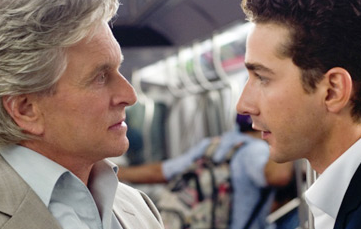
Excellent. Now I don’t have to see Wall Street: Money Never Sleeps, due to this list of things that are bizarre and wrong in the film. Such as: “EVERYTHING ABOUT CAREY MULLIGAN’S BLOG! Haha, these were the best goofs. Like in one of the first scenes of the movie, Carey tells Shia that she has to go down to Washington for a week because the blog is relaunching, and ‘the site goes down for 10 days starting tomorrow.’ Shia comments about where lefties will get their news for 10 days or something. But that’s now how website relaunches work! The site does not go down for 10 days. Ever. Then later, Carey is seen in front of her computer poring over a blog post, but it’s printed out on paper in front of her (with her picture.) Only Tina Brown prints out blog posts.”

